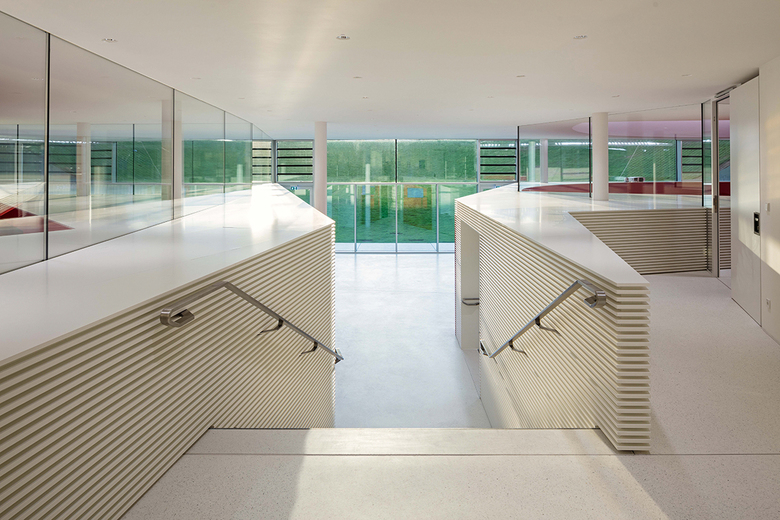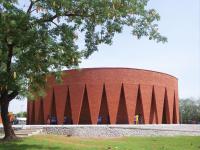Mannheim Business School Study and Conference Center
Mannheim, Germany
In Europe’s second largest baroque castle schneider+schumacher has just completed a modern study and conference centre for Mannheim Business School. Dug into the garden, the new intervention and the historic building together now form a remarkable unity that symbolizes not just the desire to safeguard tradition, but to value innovation too.
A modern campus in a baroque castle
Built in the 18th century and once the residence of the electors of the Palatinate, Mannheim Castle has been used for decades by the University of Mannheim. It functions not just as a listed building, but a living ensemble too. Now, in place of the decommissioned boiler room and its associated coal cellar dating from the 1950s, new spaces totalling 1700m2 have been built for Mannheim Business School (MBS).
The new lecture complex is accessed from the Ehrenhof via the former castle kitchen. From here, a lift and a generous staircase lead down into the double-height extension below ground. A forum opens onto two lecture rooms, a conference room, and ten so- called ‘break-out rooms’. A wide glass frontage opens up the campus to the castle garden, which dips down at this point, like an ancient Greek theatre. The green landscaping is intended to be used by students and it extends over the roof, which is also accessible.
On entering the new building, one sees the entire lecture room complex, with views extending to the garden – there’s nothing reminiscent of a coal cellar here. According to Prof. Michael Schumacher and Till Schneider, joint owners of schneider+schumacher: ”Our intention was to make sure students didn’t arrive in a dark space, but instead to make them immediately aware of the garden. This is why we chose to employ only glass for the acoustic separation of the lecture halls at high level.” The use of glazing at various levels presents those entering with kaleidoscopic views. The rooms appear as entities distributed over the surface area, since it is only glazing that connects them to the ceiling.
The semi-circular lecture theatres are accentuated with a cambered ceiling to increase the sense of openness. The doors and carpeting, right through to the desks and chairs are all coloured red – in contrast, and as a complementary colour, to the green of the castle garden. Each lecture theatre is designed for up to 60 persons, with raked rows of seating, so that those seated in the last row still have the impression of being close to the lectern. The conference room – which can be flexibly configured using sliding doors – and the forum, serving as an additional common area, both lie adjacent to the glazed frontage overlooking the castle garden. The ten break-out rooms are designed as open niches to the right of the staircase – five rooms located a few steps below the lecture rooms and a further five above, arranged along a gallery from which there is a view over the lecture rooms to the exterior.
Shortcomings of former accommodation
As an organizational umbrella for management training at the University of Mannheim, Mannheim Business School is one of the leading institutions of its kind in Europe. It offers three MBA programmes, a master's degree programme for young professionals in business auditing and tax consulting, as well as tailor-made company programmes and open courses. Founded in 2005, the number of participants has increased tenfold from 50 to 500 in ten years. In May 2017, for the fourth time in a row, it was placed in the Top 20 in the Financial Times ranking of the world's best providers of company training programmes. But the MBS was failing to triumph in one category – its teaching accommodation – which consistently scored less than average. Due to the rapidly increasing number of students, it had already reached its maximum capacity. All this is about to change with the new building. It was commissioned by the federal state of Baden-Wuerttemberg’s Assets and Construction Management Department, with its Mannheim and Heidelberg offices acting as clients. The MBS provided an overall sum of some 9 million euros and in return they have the right to use the space for a maximum of 30 years. Thereafter they will have to pay rent.
Tailored to teaching
The question facing the architects was how to carve out space for an extension from a baroque castle with only a few narrow and deep rooms, also how best to devise spaces that correspond to the MBS’s educational programme. When starting to study a topic, students usually share a lecture hall, after which the course is split up into small groups, where they work together on case studies, which they again present in a plenum session. This set-up clearly suggested an arrangement with two lecture halls, a meeting area and ten group workrooms. All these requirements had to be accommodated on site and incorporated into a pleasing and lively context.
Vice-versa effect
As Prof. Michael Schumacher puts it: “For me the most exciting thing about this project was making a baroque castle even more beautiful than it already is. The project is similar to the underground extension we built for Frankfurt’s Städel Museum, five years ago. A very beautiful and historic site needs an extension, yet it should not be in any way marred in the process. On top of this, the old and the new should together create a new unpretentious and appealing whole.”
Working with historic buildings
At the end of 2013, the state of Baden-Württemberg adopted a negotiation procedure for the construction project and in January 2014 the contract was awarded to schneider+schumacher. The phase from the initial sketches to planning approval progressed quickly and in March 2015, Baden-Württemberg’s Minister of Finance and Economics issued construction approval for the project. Construction started approximately six months later.
Working with historic buildings creates its own particular demands: The study and conference centre had to be accessed via the arcades of the west Ehrenhof wing. Material had to be excavated under extremely tight conditions from a depth of some seven metres,
and this work was only possible using mini-excavators, caterpillars and conveyor belts. The outer foundations of the castle then had to be penetrated to connect the extension to the existing building below ground level. Due to the listed status of the building and concern for the existing building fabric, demolition methods that caused the least possible amount of vibration were adopted.
Together with the static engineers, the building and project management team at schneider+schumacher often found they needed to react quickly and spontaneously. For instance, in the course of excavation, large voids in the existing foundations became evident and these had to be filled up with concrete. Occasionally, while working on the link between the new building and the existing fabric, horizontal tree trunks and a steel frame construction had to be integrated into the outer walls in order to prop up the façade. Furthermore, archaeological investigations were taking place in parallel with the building work. This brought to light Mannheim’s largest hidden trove of ‘village’ objects: fragments of clay vessels and iron slag dating from the Carolingian period to the late Middle Ages.
The casting of the concrete foundation slab marked the start of building work at Mannheim Business School in April 2016. The underground extension is supported on base plate extending over the entire area. At the intersection of new and the old, existing walls and foundations were underpinned. The lecture theatres are surrounded by a reinforced concrete framework, with load-bearing outer walls and a flat roof supported on columns. The two cambered lecture theatre ceilings emerge 125cm higher than the 45cm-deep reinforced concrete roof slab. These two domes and the flat roof were reinforced and then cast employing pumped concrete, and the topping-out ceremony in September was attended by 150 guests. The canopy roof above the glazing overlooking the castle garden consists of 15 large-format white concrete cladding panels and the curvature of the roof dictated that each one of these panels had to be specially manufactured. In spite of their minimal depth they are extremely strong, and measure 4.0m long by 2.50m wide, yet are
only 5cm deep. At the end of 2016 the scooped out garden was created and laid with a turf lawn covering an area of 850m2. A further 830m2 of turf lawn was laid over the roof surface.
Between tradition and innovation
Starting in the autumn of 2017, Mannheim Business School’s new study and conference centre will be occupied by students fine-tuning their skills for a career in top management. The new MBS flagship contributes to this process by linking tradition with innovation. The new extension is integrated into its baroque surroundings, yet its stylistic idiom is clearly attributable to the 21st century: proof that the future is firmly rooted in the past.
- Architects
- schneider+schumacher
- Location
- Mannheim, Germany
- Year
- 2017
- Client
- Vermögen und Bau Baden Württemberg Amt Mannheim und Heidelberg
- Team
- Michael Schumacher, Kai Otto, Meike Jung, Kerstin Högel, Maximilian Büschl, Hans Eschmann, Daniel Breitenstein, Alexander Hirsch, Florian Haus, Cristina Fischer de Saa, Leona Schäfer, Justina Jauniskyte





















